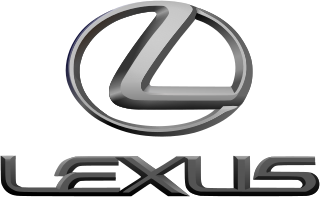
Lexus is the luxury vehicle division of the Japanese automaker Toyota. The Lexus brand is marketed in more than 90 countries and territories worldwide and is Japan's largest-selling make of premium cars. It has ranked among the 10 largest Japanese global brands in market value. Lexus is headquartered in Nagoya, Japan. Operational centers are located in Brussels, Belgium, and Plano, Texas, United States.

A pointing device is a human interface device that allows a user to input spatial data to a computer. CAD systems and graphical user interfaces (GUI) allow the user to control and provide data to the computer using physical gestures by moving a hand-held mouse or similar device across the surface of the physical desktop and activating switches on the mouse. Movements of the pointing device are echoed on the screen by movements of the pointer and other visual changes. Common gestures are point and click and drag and drop.

A game controller, gaming controller, or simply controller, is an input device or input/output device used with video games or entertainment systems to provide input to a video game. Input devices that have been classified as game controllers include keyboards, mouses, gamepads, and joysticks, as well as special purpose devices, such as steering wheels for driving games and light guns for shooting games. Controllers designs have evolved to include directional pads, multiple buttons, analog sticks, joysticks, motion detection, touch screens and a plethora of other features.
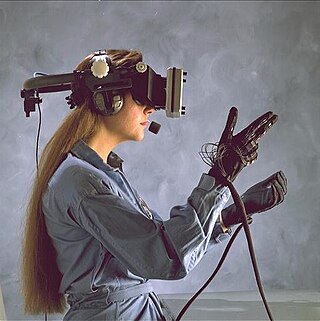
Haptic technology is technology that can create an experience of touch by applying forces, vibrations, or motions to the user. These technologies can be used to create virtual objects in a computer simulation, to control virtual objects, and to enhance remote control of machines and devices (telerobotics). Haptic devices may incorporate tactile sensors that measure forces exerted by the user on the interface. The word haptic, from the Greek: ἁπτικός (haptikos), means "tactile, pertaining to the sense of touch". Simple haptic devices are common in the form of game controllers, joysticks, and steering wheels.
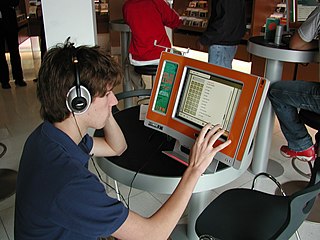
A touchscreen or touch screen is the assembly of both an input and output ('display') device. The touch panel is normally layered on the top of an electronic visual display of an electronic device.

The Lexus GS is an executive car sold by Lexus, the premium division of Toyota. The same car had been launched in 1991 as the Toyota Aristo in Japan. For non-Japanese markets, it was released as the Lexus GS in February 1993. It continued using the Toyota Aristo name for the Japanese market until January 2005.
iDrive is an in-car communications and entertainment system, used to control most secondary vehicle systems in late-model BMW cars. It was launched in 2001, first appearing in the E65 7 Series. The system unifies an array of functions under a single control architecture consisting of an LCD panel mounted in the dashboard and a control knob mounted on the center console.
An output device is any piece of computer hardware converts information into a human-perceptible form or, historically, into a physical machine-readable form for use with other non-computerized equipment. It can be text, graphics, tactile, audio, or video. Examples include monitors, printers, speakers, headphones, projectors, GPS devices, optical mark readers, and braille readers.

Intelligent Parking Assist System (IPAS), also known as Advanced Parking Guidance System (APGS) for Toyota models in the United States, is the first production automatic parking system developed by Toyota Motor Corporation in 1999 initially for the Japanese market hybrid Prius models and Lexus models. The technology assists drivers in parking their vehicle. On vehicles equipped with the IPAS, via an in-dash screen and button controls, the car can steer itself into a parking space with little input from the user. The first version of the system was deployed on the Prius Hybrid sold in Japan in 2003. In 2006, an upgraded version debuted for the first time outside Japan on the Lexus LS luxury sedan, which featured the automatic parking technology among other brand new inventions from Toyota. In 2009, the system appeared on the third generation Prius sold in the U.S. In Asia and Europe, the parking technology is marketed as the Intelligent Park Assist System for both Lexus and Toyota models, while in the U.S. the Advanced Parking Guidance System name is only used for the Lexus system.

The Lexus LX is a full-size luxury SUV sold by Lexus, a luxury division of Toyota since January 1996, having entered manufacturing in November 1995. It is Lexus' largest and most expensive luxury SUV. Four generations have been produced, all based heavily on the long-running Toyota Land Cruiser SUVs. The first-generation LX 450 started production in 1995 as Lexus' first entry into the SUV market. Its successor, the LX 470, premiered in 1998 and was manufactured until 2007. The third-generation LX debuted at the New York International Auto Show in April 2007. The fourth-generation LX debuted in October 2021.

Cockpit Management and Data system - COMAND for short - acts as a combined command and control center for all audio, telematics and telecommunications functions on Mercedes-Benz vehicles and includes a dedicated flat display screen. In addition to the GPS navigation system and general processing and control logic, COMAND includes components such as an address book, telephone, radio and in many cases a CD/DVD drive. It is connected to other devices such as CD/DVD changers, sound system and surround sound amplifier, TV receiver and the optional Linguatronic voice control system via an optical fiber network. The first generations of COMAND used the D2B optical network standard whereas later models are based on MOST.

The Lexus LF line is a series of concept cars built by Lexus, the luxury vehicle division of Toyota Motor Corporation. The "LF" designation refers to Lexus Future. The LF Series vehicles features coupes/convertibles, including: the LF-A, the LF-A Roadster, LF-LC, LF-CC, and the LF-C; sedans: the LF-S, LF-Sh, and LF-Gh; crossover SUVs: the LF-X and LF-Xh; and hatchbacks: the LF-Ch. The first concept vehicle of the LF Series, the LF-X, appeared in 2003. The LF Series utilizes L-finesse, a design philosophy named for "Leading Edge" and "finesse", which debuted on the LF Series concepts and later extended to all new production Lexus vehicles. New vehicle technologies on the LF Series include advanced instrumentation, multiple driver-selected vehicle configurations, hybrid and experimental powertrains, and unconventional driver interface designs. The vehicles also feature new design cues which derive from the L-finesse design language of "Intriguing Elegance" (純), "Incisive Simplicity" (妙), and "Seamless Anticipation" (予). Several of the LF concept vehicles have appeared close to their production counterparts, while the design cues of other LF concepts appeared on more distinctly different production vehicles.

In-car entertainment (ICE), or in-vehicle infotainment (IVI), is a collection of hardware and software in automobiles that provides audio or video entertainment. In car entertainment originated with car audio systems that consisted of radios and cassette or CD players, and now includes automotive navigation systems, video players, USB and Bluetooth connectivity, carputers, in-car internet, and WiFi. Once controlled by simple dashboards knobs and dials, ICE systems can include steering wheel audio controls, handsfree voice control, touch-sensitive preset buttons, and even touch screens on higher-end units.

The Lexus HS is a dedicated hybrid vehicle introduced by Lexus as a new compact executive car sedan in 2009. Built on the Toyota New MC platform, it is classified as a compact under Japanese regulations concerning vehicle exterior dimensions and engine displacement. Unveiled at the North American International Auto Show in January 2009, the HS 250h went on sale in July 2009 in Japan, followed by the United States in August 2009 as a 2010 model. The HS 250h represented the first dedicated hybrid vehicle in the Lexus lineup, as well as the first offered with an inline-four gasoline engine. Bioplastic materials are used for the vehicle interior. With a total length of 4,700 mm (190 in), the Lexus HS is slightly larger than the Lexus IS, but still smaller than the mid-size Lexus ES.

Vehicle Dynamics Integrated Management (VDIM) is an integrated vehicle handling and software control system developed by Toyota. It involves an omnibus computer linkage of traction control, electronic stability control, electronic steering, and other systems, with the intent of improving responsiveness to driver input, performance, and overall safety. The system was first introduced in the Japanese domestic market in July 2004, when Toyota debuted VDIM on the Toyota Crown Majesta. This was followed by the VDIM's export debut on the third generation Lexus GS, which was launched in 2005. VDIM integrates the company's Electronically Controlled Brake (ECB), Anti-Lock Brakes (ABS), Electronic Brakeforce Distribution (EBD), Traction Control (TRC) and Vehicle Stability Control (VSC) active safety systems with the Adaptive Variable Suspension (AVS), Electric Power Steering (EPS) and Variable Gear Ratio Steering (VGRS) systems which previously worked independently using proprietary software. This way all the systems function together rather than the ECU prioritizing which is the most important. VDIM was initially designed for rear-wheel drive cars.

In computing, an input device is a piece of equipment used to provide data and control signals to an information processing system, such as a computer or information appliance. Examples of input devices include keyboards, mouse, scanners, cameras, joysticks, and microphones.

Toyota Entune is an integrated multimedia navigation and telematics system for Toyota automobiles that provides satellite-based information on traffic, weather, sports scores, stocks, and fuel prices via subscription through SiriusXM. When connected to a compatible cellular phone running the Entune app via radio or USB cable, the system provides a browser and other apps including those from music services such as iHeartRadio, Pandora, and XM Satellite Radio. The cell phone app has iOS, Android, and Blackberry versions; to use this feature, a cell phone data plan is required. The system can be controlled with voice recognition, and may include the “Safety Connect” personalization system.
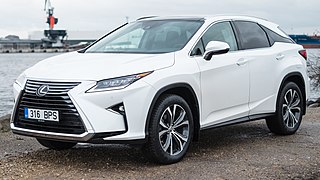
The Lexus RX is a luxury crossover SUV sold since 1998 by Lexus, a luxury division of Toyota. Originally released in its home market of Japan in late 1997 as the Toyota Harrier, export sales began in March 1998 as the Lexus RX. Considered as the first luxury crossover SUV, four generations of the RX have been produced to date, the first being compact in size, and the latter three classified as mid-size. Both front- and four-wheel drive configurations have been used on the RX series, and several gasoline powertrain options, including V6 engines and hybrid systems, have been offered. In the Lexus model lineup, the RX sits below the larger GX and LX, and above the smaller NX crossover with a lesser displacement inline-four engine. The name "RX" stands for "Radiant Crossover". It has also been labelled as "Recreational Cross Country" in some markets. The RX's current Toyota counterparts are the Highlander/Kluger; past counterparts were the Harrier and Venza.
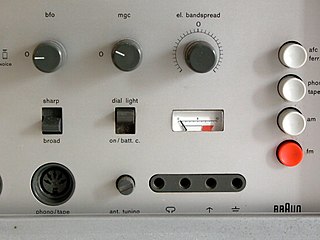
Hardware interface design (HID) is a cross-disciplinary design field that shapes the physical connection between people and technology in order to create new hardware interfaces that transform purely digital processes into analog methods of interaction. It employs a combination of filmmaking tools, software prototyping, and electronics breadboarding.





















